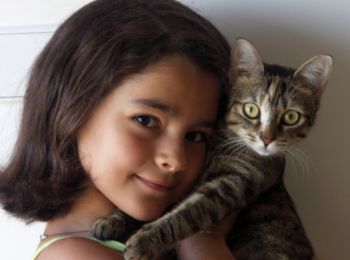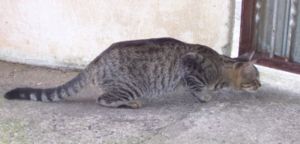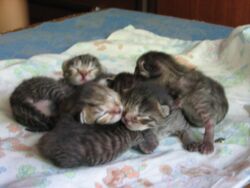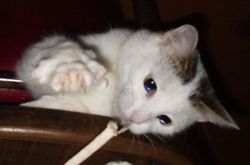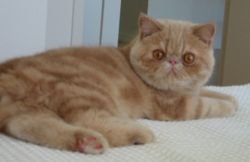Cat
| Cat | ||||||||||||||||
|---|---|---|---|---|---|---|---|---|---|---|---|---|---|---|---|---|
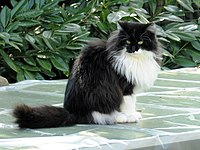 | ||||||||||||||||
| Conservation status | ||||||||||||||||
|
Domesticated
| ||||||||||||||||
| Scientific classification | ||||||||||||||||
| ||||||||||||||||
| Trinomial name | ||||||||||||||||
| Felis silvestris catus (Linnaeus, 1758) |
When it comes to domesticated animals, cats are in a class by themselves. That mix of purring intimacy and sudden aloofness known to cat owners may stem from this pet's unique ancestral "lifestyle". The forebear of the housecat, the African wild cat, was a solitary rather than a social animal. Unlike wolves, which were domesticated into the dog, and the large herd animals like horses, camels, and sheep, all of whose taming has hinged on tolerating us as group leader, cats do not depend on a spot in some organization. The technical word for a group of cats, "clowder," is rarely spoken in general conversation. The social group of the undomesticated African wild cat is neither a herd nor a pack, but a temporary family composed of a mother cat and her litter of growing kittens. Adult males (called tomcats or toms) operate independently, mixing it up only to fight other males and court and mate with females. Though the house cat has changed over the thousands of generations the species has lived with and around us, and the modern cat is more inclined to associate with other adults of its kind than its wild ancestors, (see the section on Cat Colonies below), the cat has never been, and is not now, inclined to accept orders from any kind of group leader. Cats only pay homage to the head of the household perhaps in the form of headless mice deposited at the front door, and not because a leader asked for them.
The domestic life of cats (history)
Why did we adopt such a singular creature into our homes and families?
Cats' skill at exterminating rodents practically benefits humans the most. The domestic cat, unlike most predators (including the big cats), does not hunt and kill only when hungry. Instead, the typical house cat follows the lure of the chase for its own sake. Most follow a scampering mouse or fluttering bird with focused abandon, even if completely sated. To see a cat stalk a bird, the tip of its tail twitching, the mouth spasmodically gaping, is to witness a form of intoxication. This addiction to the hunt, along with sharp teeth, an athletic pounce, silent footfalls, and sharp claws combine to make the cat a relentless assassin, who, even if gorged on prey, will continue with its work. The apparent cruelty of cats has caused many people to disdain them, but their obsession with stalking and "playing" with little moving things probably led to their domestication in the first place.
Historians document cats' first domestic presence in ancient Egypt, about 1500 BC, where granaries first appeared. Mice and other rodents multiply around large stores of grain, making cats desirable for ancient Egyptians, which evidence indicates. The ancient Egyptians mummified cats as lavishly as royalty and aristocrats, and records indicate they considered killing or harming a cat a serious crime.
The cat is one of the few domestic animals that adapts easily to shipboard life; that ability, along with a talent for the extermination of vermin, has accounted for the long term global expansion of this animal's territory. In other words, cats that managed to board seagoing vessels—invited or otherwise—have been tolerated and have thrived, seeding cat populations throughout the world even when not deliberately imported.
Health, Care, and Breeding of Cats
The features of the cat
Cats thrive in most homes.
Weighing on average between 2.5 and 7 kg (5.5–16 pounds), the narrow range of size between the vast majority of healthy weight adult cats differs from the great size differences between the largest and smallest breeds of dogs or horses. Purebred cats, a small minority, tend to represent the extremes of size and other features. The Maine Coon [1], for example, is one of the largest and heaviest, sometimes 11.3 kg (25 pounds) in lean weight and the Korat [2] one of the smallest, only about 3 kg (6-7 lbs).
Cats live 10 to 20 years, and usually longer if owners keep them indoors. Restricting the cat to an indoor life reduces the risk of injury from other cats, dogs and wild predators, as well as motor vehicle accidents and exposure to diseases. Spayed or neutered cats also tend to live longer. In captivity, well-cared for indoor cats often live 14 to 20 years, with 36 years being the record for the oldest pet cat.[1] Although cats given the freedom to go outside tend to die younger, some of these inside/outside cats live a long time.
Eyes and Vision
Testing indicates cats see better at night than humans, but not as well in daylight. The cat's tapetum lucidum, as with dogs and many other animals, reflects extra light to the retina. A camera's flash interacts with the tapetum to make the cat's eye color vary in photographs. While this structure enhances the ability to see in low light, it reduces net visual acuity, and so the cat's pupil can close enough to eliminate much of the incoming daylight. In very bright light, the slit-like iris closes very narrowly over the eye, reducing the light on the sensitive retina, and improving depth of field. Cats can thus detect light seven times more sensitively than humans.
Cats' field of view, estimated at 200° (20° wider than humans'), has a narrower central binocular field (the overlap in the images from each eye) than humans'. As with most predators, including us, their eyes face forward, affording depth perception at the expense of field of view, which largely depends upon the eyes' placement, but may also relate to the eye's construction. Instead of the fovea which gives humans sharp central vision, cats have a central band known as the visual streak. Cats can apparently differentiate among colors, especially at close range, but without appreciable subtlety. Like many animals, the cat's nictitating membrane, a translucent "third eyelid," closes from the side to thinly cover the eye, and appears when the cat's eyelid first opens. A sick cat's nictitating membrane partially closes, but a sleepy, content cat's membrane is often visible. If a cat chronically shows the third eyelid, it should be taken to a veterinary surgeon.
Ears and Hearing
Humans and cats hear low frequencies similarly, but cats can hear much higher-pitched sounds - up to 64,000 kHz, which is 1.6 octaves above the range of a human, and even an entire octave above the range of a dog.[2] In most animals, the ear is "tuned" to hear the sounds most important for species survival, and that means the sounds of its kind, its prey and its predators. Cats' excellence, for example, at hearing faint, high-pitched sounds helps them locate rodents' nests. Cats swivel their hears toward the direction they're listening, and a cat's ear flaps (pinnae) can independently point backwards, forwards, and sideways to pinpoint the source of the sound. Cats can judge within three inches (7.5 cm) the location of a sound made one yard (approximately one meter) away - another attribute adding to their consumate skill at hunting.
Sense of Smell
Cats have twice as many smell-sensitive cells in their noses as people, and can likely smell odors we never sense. The cat's scent organ in the roof of its mouth, called the vomeronasal, or Jacobson's organ, causes extreme sensitivity toward open flames, fire, or burning objects. When a cat wrinkles its muzzle, lowers its chin, and lets its tongue hang a bit, it is opening the passage to the vomeronasal. This is called gaping, "sneering", or "flehming", which equates to the Flehmen response in other animals, such as dogs, horses and big cats.
Touch
Cats generally have about a dozen whiskers in four rows on each upper lip, a few on each cheek, tufts over the eyes, and bristles on the chin. Whiskers may also be on the cat's inner "wrists", and similar hairs make up the cat's eyebrows. The Sphynx (a nearly hairless breed) may have full length, short, or no whiskers at all.
Whiskers (called vibrissae) can aid with navigation in the dark. Whiskers may detect very small shifts in air currents, alerting a cat to an unseen obstruction's proximity. The upper two rows of whiskers can move independently from the lower two rows for even more precise measuring. These whiskers also spread out roughly as wide as the cat's body, enabling it to judge if it can fit through an opening. Cats also have a number of reinforced hairs similar to whiskers on other parts of their bodies: over the eyes, on the chin and at the back of the legs. [3]
Taste
Cats cannot taste sugary foods due to a faulty sweet receptor gene.
Legs
Cats, like dogs, are digitigrades: they walk directly on their toes, the bones of their feet making up the lower part of the visible leg. Cats can walk very precisely because like all felines they directly register, that is, they place each hind paw almost directly in the print of the corresponding forepaw. Such walking minimizes noise and visible tracks and provides sure footing for their hind paws when navigating rough terrain.
Unlike dogs, cats walk by moving both legs on one side and then both legs on the other, a type of 'pacing gait'.
Like all members of family felidae, with the exception of the cheetah, house cats have retractable claws. In the normal, relaxed position the skin and fur around the toe pads sheaths the claws, keeping them sharp by preventing wear from contact with the ground and allowing the silent stalking of prey. The forefoot's claws are usually sharper than the hindfoot's. Cats can extend their claws voluntarily on one or more paws at will. Cats may extend their claws in hunting or self-defense, climbing, "kneading", or for extra traction on soft surfaces (bedspreads, thick rugs, etc.).
Most cats have four claws on each of their hind paws and five on their front paws, but an allele in the gene pool makes them prone to polydactyly, and some have six or seven toes. One breed, the Maine Coon, has a particularly high rate of polydactyly.
Body Type
Coat and Eye color
Cats come in a variety of colors, solid colored or striped.
Cats not only have many different eye colors, most typically yellow, copper, green, and orange, but some (odd eyed) varieties even feature two different colors. Purebred cats' eye color is often specified as a feature of the breed standard. Blue eyes are associated with the Siamese breed, though white cats also have them. White cats with two blue eyes are often deaf; orange eyes, however, usually indicate the cat hears normally. White cats having one blue and one other-colored eye are called "odd-eyed" and may be deaf on the same side as the blue eye.[3]
Fur (or lack of it)
Body Language of Cats
Normally born in a litter and raised by the mother, cats communicate with each other vocally and bodily. Cats also emit odors other cats interpret, but humans can't consciously understand these signals. The facial expressions, sounds, body postures and movements of paw and tail, however, can be read.
Whiskers also indicate the cat's attitude, pointing forward when the cat is inquisitive and friendly, and lying flat back on the face when defensive or aggressive. Whereas a dog wags its tail to signal friendly intentions, a cat twitches its tail to signal the opposite mood.
Vital signs
Normally between 38 and 39 °C (101 and 102.2 °F),[4] a cat's body temperature is considered febrile (hyperthermic) when above 39.5 °C (103 °F), or hypothermic if below 37.5 °C (100 °F). For comparison, humans have a normal temperature of approximately 36.8 °C (98.2 °F). A domestic cat's normal heart rate ranges from 140 to 220 beats per minute, and largely depends on how excited the cat is. For a cat at rest, the average heart rate should be between 150 and 180 bpm, about twice that of a human.
Making a home for a cat
Most breeds of cat have a noted fondness for settling in high places, or perching.
The litter box
Indoor cats may be provided a litter box containing sand or similar material (litter). This arrangement serves the same purpose as a toilet for humans. It should be cleaned daily and changed often (depending on the number of cats in a household and the type of litter; clumping litter stays cleaner longer, but has been reported to cause health problems in some cats. [5]) A litterbox is recommended for indoor-outdoor cats as well. Litterboxes may pose a risk of toxoplasmosis transmission to susceptible pregnant women and immuno-compromised individuals. Transmission risk may be reduced by daily litterbox cleaning by someone other than child-bearing women.
Hunting and diet
Even the most well-fed of domestic cats will hunt and kill birds, mice, rats and other small animals when given the opportunity. They often present such trophies to their owner. The motivation is not entirely clear, but friendly bonding behaviors are often associated with such an action. Due to their ceaseless hunting, cats are hazardous to small animals, including locally endangered bird species. In some cases, cats have contributed to or caused extinctions -— for example, see the case of the Stephens Island Wren. It is fair to say that is not just the cat who lives longer when it is kept indoors and not allowed free access outside.
Still, even an indoor cat has access to prey in many homes. Although there have been individual house cats who have tolerated the company of birds (even allowing close contact with small birds), generally any small animal kept as a pet in the house must be sequestered away from the cat's presence. Cats can terrorize small creatures in cages, even when they cannot actually physically reach them. Wild rodents inside the home are, of course, fair game to a house cat and many owners keep cats for their skill at eliminating vermin indoors. However an owner feels about this activity, approving or disapproving, it is likely to go on as long as mice and their kind are present in a home shared by a cat. The cat who has contact with wild rodents and other wild animals that make their way into the home ( like bats) is potentially exposed to certain parasites (for example, tapeworrms), and both bacteria and viruses that can cause disease. This is why even strictly indoor cats need to be protected from such diseases as rabies by vaccination, and why the duty of cleaning out the cat box may spread toxoplasmosis to a human owner .
In captivity, cats cannot live on an unsupplemented vegetarian diet because they cannot synthesize several nutrients they need and that are absent or rare in plant food. This applies mainly to taurine, vitamin A (cats cannot convert the pro-vitamin A that is abundant in plants to vitamin A proper) and to certain fatty acids. The absence of taurine causes the cat's retina to slowly degenerate, causing eye problems and (eventually) irreversible blindness. This condition is called central retinal degeneration (CRD). Cow's milk is a poor source of taurine and adult cats are generally lactose intolerant. Lactose-free milk is perfectly safe, but still is not a substitute for meat.
In nature, cats are almost never overweight, but obesity is recognized as a health problem among pet cats.
Some houseplants are harmful to cats. The leaves of the Easter Lily can cause permanent and life-threatening kidney damage to cats. Philodendron are also poisonous to cats. Cat Fancy has a full list of plants harmful to cats.
Most cats have a fondness for catnip. While they generally do not consume it, they will often roll in it, paw at it, and occasionally chew on it (as catnip is sensed by the cat's Vomeronasal organ). The effect is usually relatively short, lasting for only a few minutes. After two hours or less, susceptible cats gain interest again. Several other species of plants cause this effect, to a lesser degree.
Because of their small size and lack of prolonged persistance in any attack, cats pose little direct danger to humans — the main hazard is the possibility of infection (e.g., cat scratch disease, or, rarely, rabies) from a cat bite or scratch.
Hygiene
Cats are known for their fastidious grooming. They groom themselves by licking their fur, employing their hooked pappilae and saliva. Their saliva is a powerful cleaning agent, but it can provoke allergic reactions in humans. Many cats also enjoy grooming humans or other cats. Some cats occasionally regurgitate hair balls of fur that have collected in their stomachs as a result of their grooming. Longhair cats are more prone to this than shorthairs. Hairballs can be prevented with certain cat foods and remedies that ease elimination of the hair and regular grooming of the coat with a comb or stiff brush. Cats expend nearly as much fluid grooming as they do urinating.
Some cats have been succesfully toilet trained, eliminating the litterbox and its attendant expense and smell.
Indoor cats will also benefit from being provided with a scratching post so they are less likely to ruin furniture with their claws. No matter how well used a scratching post might be by some cats, other individual cats do not use them at all.
Declawing
Declawing is a major surgery known as onychectomy, performed under anesthesia, that removes the tip of each digit (from the first knuckle out) of the cat's forepaws (and sometimes the hind paws). Veterinarians are generally critical of the procedure and some refuse to perform it. Declawing surgery can be done in two ways, by incision or laser. Laser declaw is considered more humane because although it is done under anesthesia, the cat normally recovers much faster as minimal bleeding occurs and the laser both removes the claw and cauterizes the wound.
The Cat Genome Project, sponsored by the Laboratory of Genomic Diversity at the U.S. National Cancer Institute Frederick Cancer Research and Development Center in Frederick, Maryland, focuses on the development of the cat as an animal model for human hereditary disease, infectious disease, genome evolution, comparative research initiatives within the family Felidae, and forensic potential.
Despite its reputation as a solitary animal, the domestic cat is social enough to form colonies, but does not attack in groups as do lions. Some breeds like bengal, ocicat and manx are very social, but these breeds are exceptions. While each cat holds a distinct territory (sexually active males having the largest territories, and neutered cats having the smallest), there are "neutral" areas where cats watch and greet one another without territorial conflicts. Outside these neutral areas, territory holders usually aggressively chase away stranger cats, at first by staring, hissing, and growling, and if that does not work, by short but noisy and violent attacks. Fighting cats make themselves appear more impressive and threatening by raising their fur and arching their backs, thus increasing their visual size. Cats also exhibit this behavior while playing. Attacks usually comprise powerful slaps to the face and body with the forepaws as well as bites, but serious damage is rare; usually the loser runs away with little more than a few scratches to the face, perhaps the ears. Normally, serious negative effects will be limited to possible infections of the scratches and bites; though these have been known to sometimes kill cats if untreated. Sexually active males will usually be in many fights during their lives, and often have decidedly battered faces with obvious scars and cuts to the ears and nose. Not only males will fight; females will also fight over territory or to defend their kittens, and even neutered cats will defend their (smaller) territories aggressively.
Cats in the wild, and feral cats
Unlike the wild counterpart to other common domesticated animals, like wild horses and wolves, the original undomesticated wild cat has continued to flourish as a successful species in the wild. Meanwhile, the domesticated population of cats has skyrocketed. Not all of these domestic cats are cared for as pets. Some live as barn cats and carry on the tradition of the first of the domesticated cats in the Egyptian graineries. More, however, are stray cats, abandoned - they often survive at least long enough to breed and, unlike their wild counterparts, not uncommonly remain together in groups as the kittens grow. Stray and abandoned pet cats are a world-wide problem. In 1995, at least 307,626 cats were put down by local municipalities throughout Japan (The plight of abandoned pets: Thrown out with the city's garbageKyoko Sato. Japan Times (International). Tokyo: Feb 9-Feb 15, 1998. Vol. 38, Iss. 6; p. 7 )
Feral cats may live alone, but most are found in large groups called feral colonies with communal nurseries, depending on resource availability. Urban areas in the developed world are not friendly, nor adapted, environments for cats; most domestic cats are descended from cats in desert climates and were distributed throughout the world by humans. Nevertheless, some feral cat colonies are found in large cities, e.g., around the Colosseum and Forum Romanum in Rome.
However, there are thousands of volunteers and organizations that trap these unadoptable feral felines, spay or neuter them, immunize the cats against rabies and feline leukemia, and treat them with long-lasting flea products. Before release back into their feral colonies, the attending veterinarian often nips the tip off one ear to mark the feral as spayed/neutered and inoculated, as these cats will more than likely find themselves trapped again. Volunteers continue to feed and give care to these cats throughout their lives, and not only is their lifespan greatly increased, but behavior and nuisance problems, due to competition for food, are also greatly reduced. In time, if an entire colony is successfully spayed and neutered, no additional kittens are born and the feral colony disappears. Many hope to see an end to urban feral cat colonies through these efforts.
Overpopulation
According to the Humane Society of the United States, 3-4 million cats and dogs are euthanized each year in the United States and many more are confined to cages in shelters because there are significantly more animals being born than there are homes. Spaying or neutering pets helps keep the overpopulation down. [4] Local humane societies, SPCA's and other animal protection organizations urge people to spay or neuter their pets and to adopt animals from shelters instead of purchasing them.
Varieties of domestic cat
The list of cat breeds is quite large: most cat registries recognize between 35 and 70 breeds of cats, and several more are in development, with one or more of new breeds being recognized each year on average, having distinct features and heritage. When choosing a cat, the purebred breed or variety of mixed breed cat should be considered. The owners and breeders of show cats compete to see whose animal bears the closest resemblance to the "ideal" definition of the breed (see selective breeding). Due to common crossbreeding in populated areas, many cats are simply identified as belonging to the homogeneous breeds of domestic longhair and domestic shorthair, depending on their type of fur. In the United Kingdom and Australia, non-purebred cats are referred in slang as moggies (derived from "Maggie", short for Margaret, reputed to have been a common name for cows and calves in 18th-century England and latter applied to housecats during the Victorian era).[6] In the United States, a non-purebred cat is sometimes referred to in slang as a barn or alley cat, even if it is not a stray.
Cats come in a variety of colors and patterns. These are physical properties and should not be confused with a breed of cat.
Household cats are divided into:
Coat patterns
Cat coat genetics can produce a variety of coat patterns. Some of the most common are:
- Bicolor, Tuxedo and Van
- This pattern varies between the tuxedo cat which is mostly black with a white chest, and possibly markings on the face and paws/legs, all the way to the Van pattern (named after the Lake Van area in Turkey, which gave rise to the Turkish Van breed), where the only colored parts of the cat are the tail (usually including the base of the tail proper), and the top of the head (often including the ears). There are several other terms for amounts of white between these two extremes, such as harlequin or jellicle cat. Bicolor cats can have as their primary (non-white) color black, red, any dilution thereof and also tortoiseshell (see below for definition).

- Tabby cat
- Striped, with a variety of patterns. The classic "blotched" tabby (or "marbled") pattern is the most common and consists of butterflies and bullseyes. The "mackerel" or "striped" tabby is a series of vertical stripes down the cat's side (resembling the fish). This pattern broken into spots is referred to as a "spotted" tabby. Finally, the tabby markings may look like a series of ticks on the fur, hence the "ticked" tabby, which is almost exclusively associated with the Abyssinian breed of cats. The worldwide evolution of the cat means that certain types of tabby are associated with certain countries; for instance, blotched tabbies are quite rare outside NW Europe, where they are the most common type.
References
- ↑ Feline Statistics. Retrieved on August 15, 2005.
- ↑ Strain, G.M., How Well Do Dogs and Other Animals Hear?
- ↑ White Cats, Eye Colours and Deafness. Retrieved on 2006-09-05.
- ↑ Normal Values For Dog and Cat Temperature, Blood Tests, Urine and other information in ThePetCenter.com. Retrieved on August 8, 2005.
- ↑ Suspected bentonite toxicosis in a cat from ingestion of clay cat litter. Retrieved on September 10, 2005.
- ↑ "Moggie" definition question and answer Worldwidewords.org. URL Accessed June 14, 2006.
